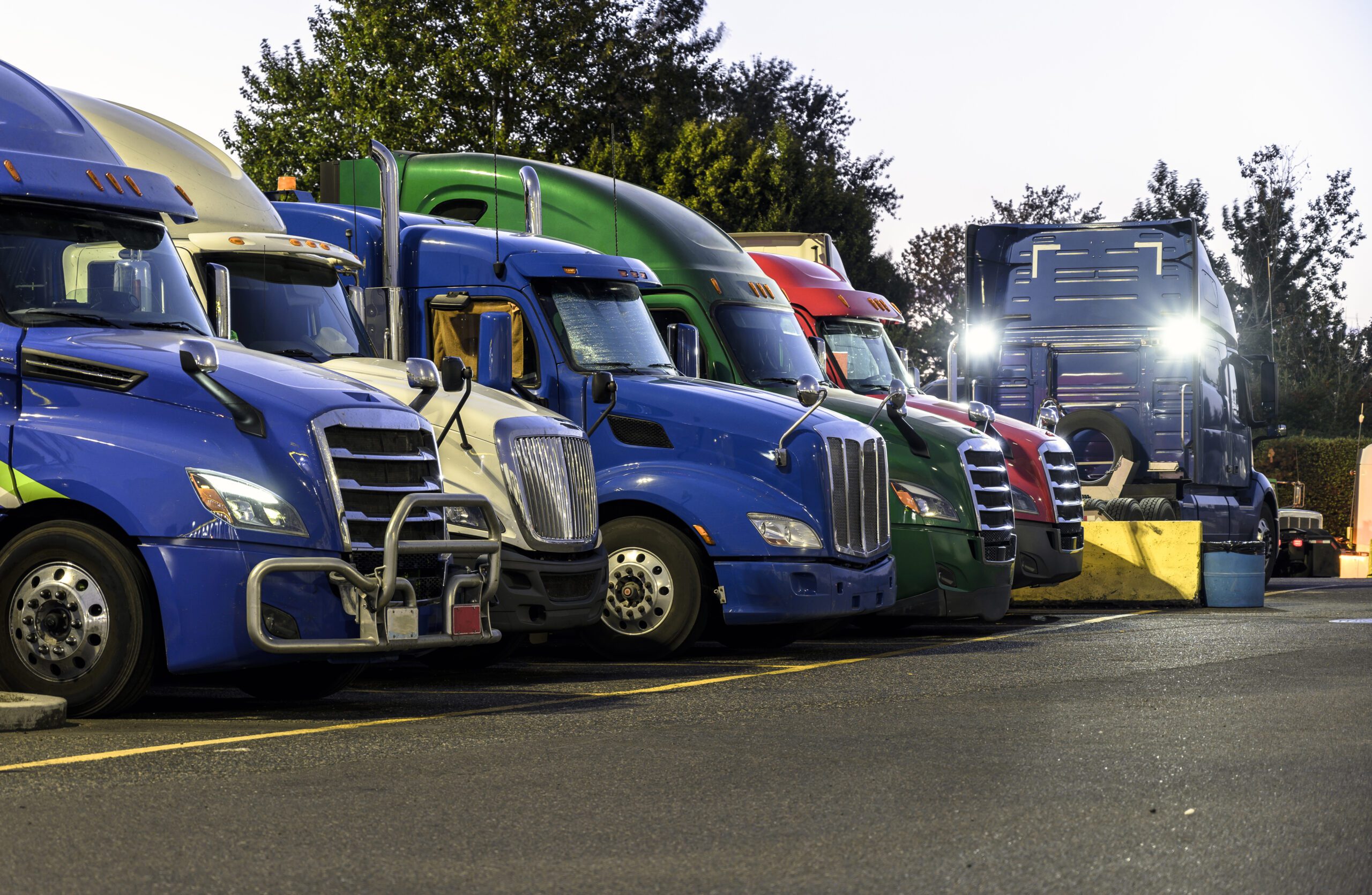Tackling the Truck Parking Shortage: Tips for Finding a Place to Park Your Semi-Truck
One of the biggest challenges drivers face on a daily basis is finding a place to park their truck at the end of the day. It is common for a driver to have a hard time finding a safe place to park when they are required to take their mandated break for the day. There are several reasons for the semi-truck parking shortage so let’s take a look at a few of them.
Truck Stops Do Not Have Enough Parking
When a new truck stop is built many of them will build nowhere enough capacity for the parking demand. Why is this? It can come down to local city regulations limiting the number of parking spots to help reduce local pollution or perhaps the land is too expensive to provide 100 parking spots. Sometimes it may just not be in the best interest of a truck stop to build all of those extra spaces. Especially if the average driver is sleeping in their truck and not spending their hard-earned cash at the truck stop. When you have more trucks, this also means extra cleaning up after them. Everything from emptying the trash to having to pay more employees for monitoring a larger lot. It is quite common for truck stops to run out of parking by the early evening and then this forces the driver having to look for alternative parking which is rarely easy to find.
Truck Parking at Rest Areas
The parking capacity of rest areas vary widely from state to state. Some states such as Florida have many large rest areas for trucks to park in. Other states do not want trucks to park in them at all and you will see the signs stating so. If a truck driver cannot find a parking spot at a truck stop, they will often look to park at the nearest rest area if there is one. In my experience the advantage of parking at a rest area is sometimes they are quitter. So, you are able to get a better night’s sleep. A major disadvantage of parking your truck at a rest area for your ten-hour break is the lack of facilities. Most will only have bathrooms and perhaps a few vending machines. Your choices for cleaning up or grabbing a meal are going to be limited. The other disadvantage is they may be less safe depending on how well lit they are and if it is staffed by security or not. A lot of truck stops have good lighting and have employees keeping an eye on events happening in and around the parking lot.
Weigh Station Truck Parking
Depending on what state you are in parking your big rig at a weigh station for the night may be an option. This is not always the case so be on the lookout to see if any other trucks are parked there and also pay close attention for a truck parking sign when you are passing through one. If there is no sign mentioning parking or no other trucks parked this is a good indication you cannot park your truck, there overnight. The downside to parking at a weigh station are a lack of facilities such as restrooms or a place to buy food. The advantage of parking at a weigh station is they are usually more secure if they are open. Afterall DOT officers are on site. They are usually well lit but not always. They may be much quieter than parking at an overcrowded truck stop.
The No Truck Parking Sign
If you have driven for any length of time, you will quickly realize that there are no truck parking signs everywhere. And I mean about anywhere that a truck can fit there is a good chance you will find a sign telling you that parking is not allowed there. Why is that? Probably because another truck parked there before and for whatever reason someone did not like it and so they had a sign put up. On occasion you may come across trucks parked in an area with no parking signs. The only reason they are there is likely because they had no alternative before their 14-hour clock ran out. Be careful however parking in an area where trucks are restricted, however. You may hear a knock on your door a couple of hours into your sleep from a security guard or state trooper telling you to move. I have had this happen more than once. Or worse you may have a wheel lock placed on your truck that will not allow you to move until you pay a shady looking gentleman outside a $500 fine for parking there. Yes, regrettably this does happen and there is a whole mini-industry built upon giving truck drivers tickets who are just trying to get some rest after a long hard day’s work. It will always be in your best interest to avoid parking in places where there are no truck parking signs.
Parking on Interstate Exit Ramps
A widespread practice in trucking is to park your truck on the side of an onramp providing there is a wide enough shoulder to do it. There are a couple of problems with this. Any car accelerating to get onto the interstate will be just a few feet away and could in theory hit you and cause an accident. If you are parked on an off ramp as a car slows down, it could hit your truck because they will be passing pretty close at an initial high speed. The best thing to do is not park on ramps at all if possible. Or if you do keep it at a short duration. Take care of what you need to and get off the ramp. There will be times where you will see other trucks parked on an exit ramp simply because, they have no other options on where to park for the night.
Parking in Abandoned Lots
This is the most dangerous area you can park at. Especially if you are parked with no other trucks in the area. Truckers tend to look out for each other, so it is always a good idea to park where other trucks are. There is safety in numbers. This is going to depend on the area, but it is ill advised to park by yourself somewhere for an extended period of time at a deserted strip mall, gas station or similar areas. Regrettably, there are shady people out there looking for easy targets so try not to be one.
Parking at Shipper and Receivers
Some shippers or receivers will let you park at their location for your 10-hour break if you ask them. Most will not have parking for you though. But an occasional one will have a lot on site or close by where trucks can park. It never hurts to ask the guard shack where the other drivers are parking at. I have found this helpful many times.
Parking Your Truck on Uneven Elevation
Not everywhere is flat and this includes areas where trucks can park. Sometimes you may park your truck where your head is laying lower than your feet in your bunk. When this happens, the quick fix is to simply swap your pillows around and sleep on the side where your head is higher to not disrupt your bodies blood flow. Other times you may be parked on an incline where your body wants to roll off the bunk. It is always best to find a flat place to park your truck when possible.
Staying Safe in a Truck Parking Lot
The most important thing here is to be visible for other drivers who are driving through the lot and always have a plan of escape if a truck happens to be coming your way too fast. Never walk too close in front of a truck when passing a row where a driver cannot see you. I always get a visual to see if a driver in the driver’s seat and listen if the truck is running before planning how close I will get to walking out in front of a truck in a truck stop. It is usually not a good idea to walk in the middle of a truck stop lot where a lot of incoming and outgoing traffic is taking place. All it takes is one trucker speeding and not paying attention to get you run over. A lot of truckers wear highly visible clothing such as safety yellow when traversing a parking lot. It may not be the best-looking fashion statement but it sure beats getting in the path of an 80,000 LB truck.
Truck Parking Summary
As with all thing’s in trucking safety is number one. Regrettably, there is not enough adequate truck parking in many areas of the country. This leads to more drivers who are fatigued forced to drive for a longer period than they should. Having been there many times myself I can tell it can get downright dangerous after you have driven close to 11 hours and are unable to find a safe place to park. I always make a rule to start looking a couple of hours before my shift is up to see what truck stops or rest areas are ahead along my route. Then I will do the math and pick the one that makes the most sense to stop at. It is also best to have a backup spot to park at in case your first planned parking area is full. This will happen a lot and takes the stress off of finding another spot if you are short on driving hours.




